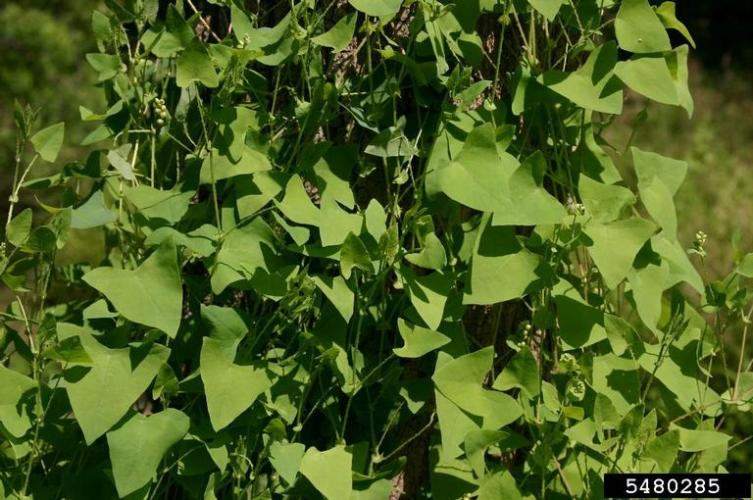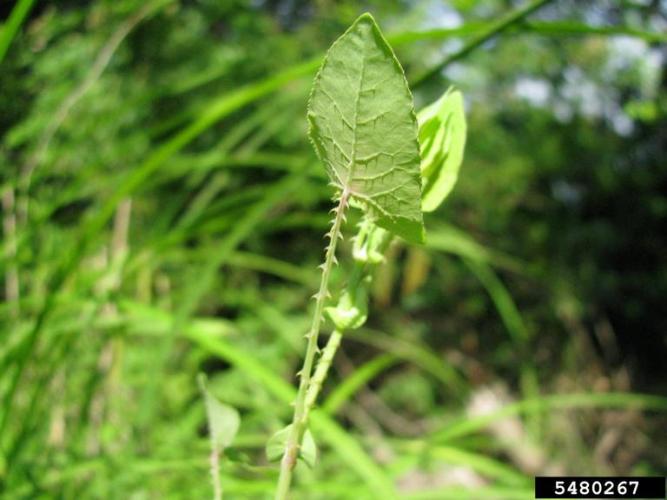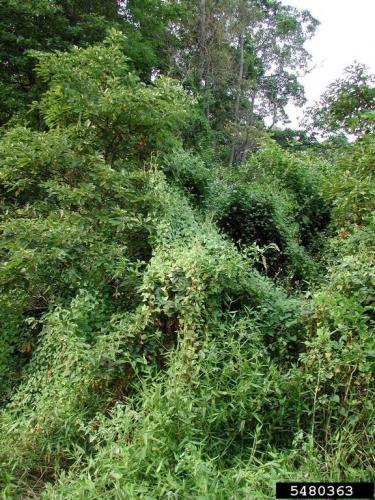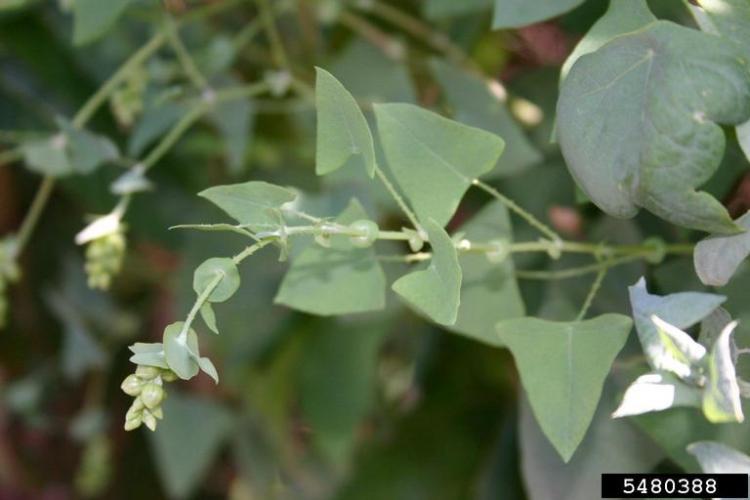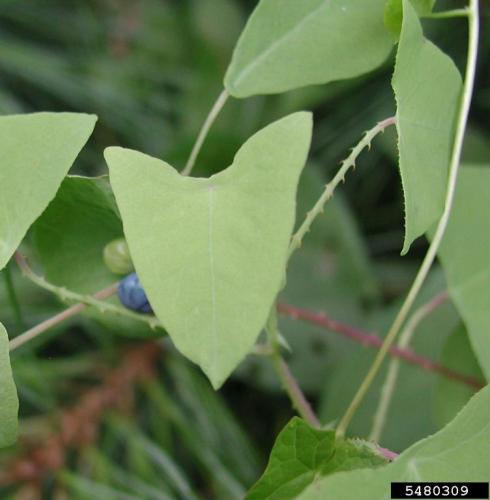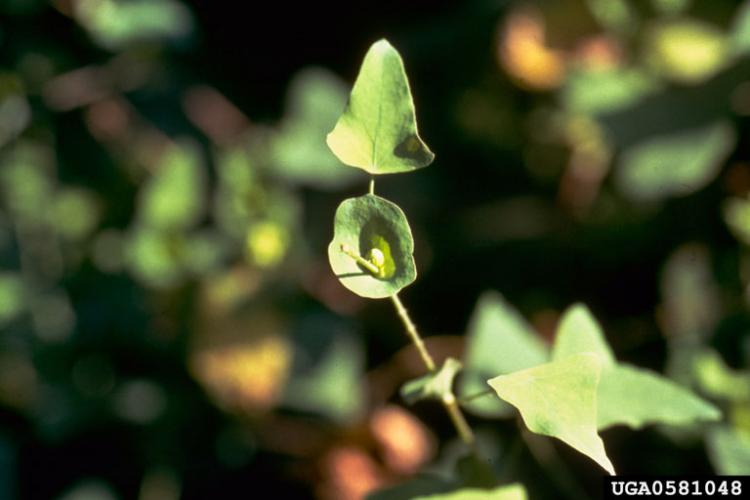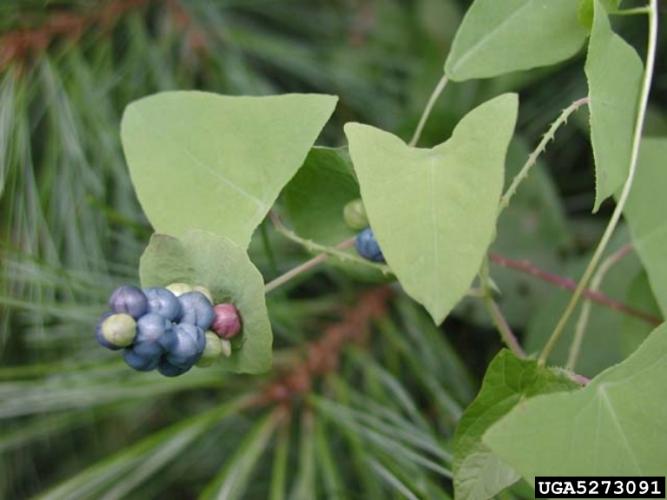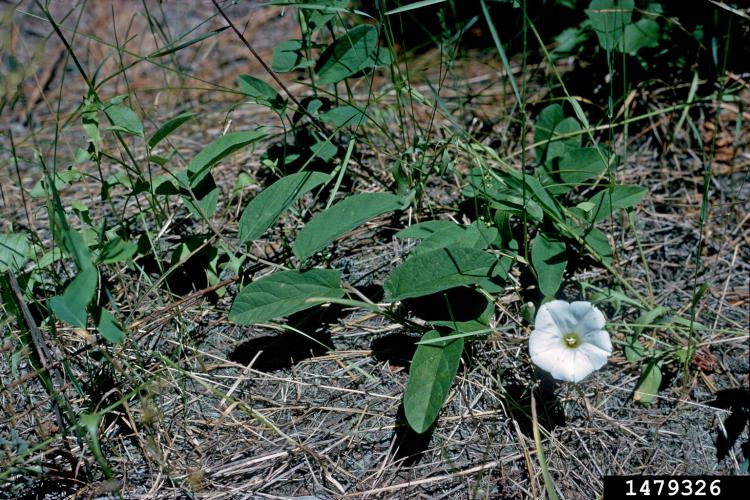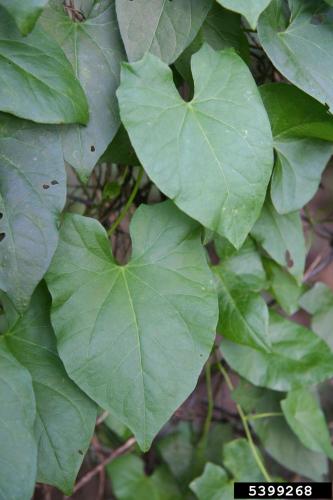Mile-a-minute vine
Identification
Appearance
Persicaria perfoliata is an herbaceous, annual vine that invades disturbed areas. The delicate stems are reddish, highly branched and covered with small, curved spines. Circular, leafy structures (ocreae) surround the stem at the base of the petioles.
Foliage
The alternate leaves are triangular, light green, 1-3 inches wide and barbed on the undersurface.
Flowers
Small, white, inconspicuous flowers arise from the ocreae (a structure formed of stipules fused into a sheath surrounding the stem).
Fruit
Fruit are present in mid-July through the first frost, are metallic blue and segmented with each segment containing a single black or reddish black seed. Seeds can remain viable for up to 6 years.
Biology
Origin
Mile-a-minute vine is native to Eastern Asia and the Philippines and was introduced several times into the United States from the late 1800s to the 1930s, possibly by seeds in nursery stock.
habitat
open and disturbed areas with a preference for very wet soil. Typical infestation areas include stream banks, open fields, roadsides, forest edges, and fence lines. Mile-a-minute weed thrives with abundant sunlight and uses its recurved barbs to attach to and climb over other plants.
Life Cycle
Mile-a-minute weed is primarily a self-fertile plant and does not need any pollinators to produce viable seeds. Seed production takes place from June-October. Seeds can be viable in the soil for up to 6 years and can germinate at staggered intervals. Vines are killed by frost and the seeds overwinter in the soil. Mile-a-minute seeds require an 8 week cooling period (at temperatures below 10 degrees Celsius) in order to flower. Germination happens in early April through early July.
Fruits are eaten by birds, deer and small mammals which can spread seeds miles away from the original plant.
Mile-a-minute weed seeds can float for 7-9 days, which allows for long distance movement in water. This movement can be amplified during storms when vines hanging over waterways drop their fruit into fast moving waters, which then spread the seeds throughout a watershed.
Ecological Threat
This species can grow up to 25 feet in six to eight weeks. Dense, prickly thickets overtake native vegetation. Christmas tree farms, orchards, reforestation and restoration areas are at risk because of the vine’s propensity to smother tree
and plant seedlings. Seeds may survive in the soil for up to six years.
Vermont Distribution
One confirmed report in Chittenden County in 2023. Staff from VAAFM, FPR and F&W collaborated to eradicate detected population. Follow up monitoring is planned.
How You Can Help
Mile-a-minute is on the early detection list of plant species. Early detection of new infestations increases our ability to slow their spread and potentially eradicate them from affected areas.
Citations
Photo credit
Mile-a-minute vine foliage, 5480285, Leslie J. Mehrhoff, University of Connecticut, Bugwood.org.
Mile-a-minute vine leaf and stem, 5480267, Leslie J. Mehrhoff, University of Connecticut, Bugwood.org
Mile-a-minute vine infestation, 5480363, Leslie J. Mehrhoff, University of Connecticut, Bugwood.org
Mile-a-minute vine flower, 5480388, Leslie J. Mehrhoff, University of Connecticut, Bugwood.org
Mile-a-minute vine leaf shape, 5480309, Leslie J. Mehrhoff, University of Connecticut, Bugwood.org
Mile-a-minute fruiting spike, ocreae, and barbs, 5273091, Leslie J. Mehrhoff, University of Connecticut, Bugwood.org
Mile-a-minute vine flowers inside cup-like leaf bracts, 0581048, Jil Swearingen, USDI National Park Service, Bugwood.org
Hedge bindweed flower, 1479326, Alex Katovich, Bugwood.org
Hedge bindweed leaf, 5399268, Robert Vidéki, Doronicum Kft., Bugwood.org
information credit
Center for Invasive Species and Forest Health, Mile-a-minute vine
